NIR therapy works for diabetic wounds by enhancing cellular metabolism and improving blood flow. The therapy penetrates your skin, activating biochemical reactions that boost ATP production. This helps reduce inflammation and oxidative stress while promoting collagen synthesis and angiogenesis, supplying more oxygen and nutrients to the damaged tissue. You'll notice that healing times drastically decrease—often from 40 days to just 21. It also protects mitochondria from damage and promotes cell proliferation and migration. This combination creates an ideal environment for healing, and you can explore more about the benefits and future advancements in NIR therapy.
Mechanism of NIR Therapy
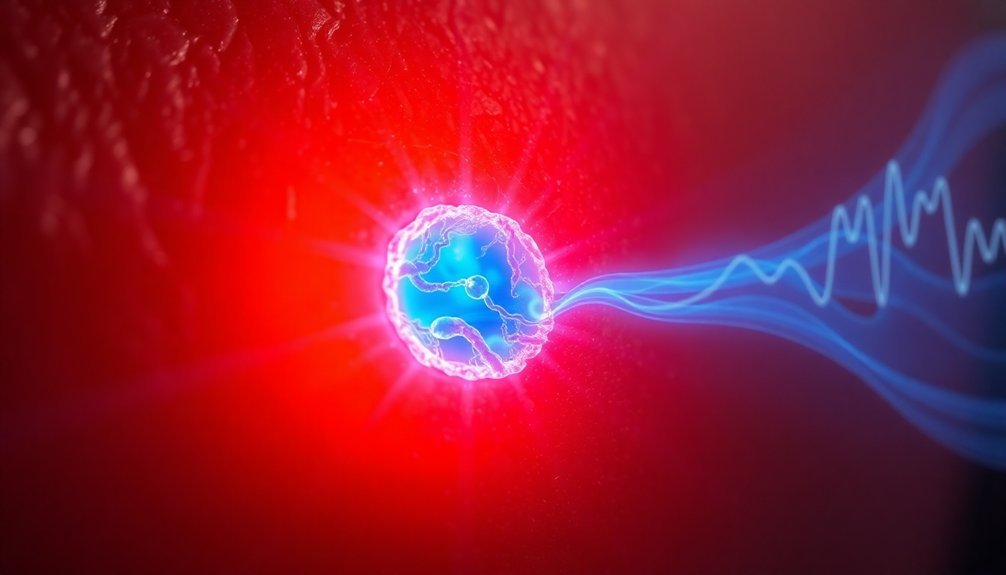
How does NIR therapy work at the cellular level? When you use near-infrared (NIR) light on your skin, it penetrates deeply into your tissues, activating important biochemical reactions.
This light interacts with cellular chromophores like cytochrome c oxidase, which boosts ATP production and optimizes your cellular metabolism. As these processes ramp up, you'll notice enhanced energy production and reduced oxidative stress in your cells.
Additionally, NIR therapy stimulates various signaling pathways that promote cell proliferation and differentiation. Notably, while it increases the production of reactive oxygen species (ROS), it's at controlled levels that can actually benefit your healing process. These ROS help invoke cellular responses that further support tissue repair. Furthermore, this therapy is known to enhance blood circulation in the wound area, promoting faster healing and tissue regeneration.
Blood Flow Enhancement
Enhanced blood flow is essential for the healing of diabetic wounds, and NIR therapy greatly supports this process. By increasing nitric oxide (NO) production in your blood, NIR therapy improves circulation, particularly beneficial for venous and diabetic ulcers. Studies show that using FIR treatments elevates blood perfusion in the wound area, with more significant results seen after longer sessions. Moreover, a recent study from Colorado shows that patients treated with FDA-cleared infrared energy devices saw remarkable progress in wound healing.
NIR therapy promotes angiogenesis, or the formation of new blood vessels, around the wound. This process is fueled by increased expressions of critical growth factors like vascular endothelial growth factor (VEGF) and endothelial nitric oxide synthase (eNOS). The enhanced neovascularization leads to faster healing times and improved outcomes for patients.
Clinical evidence backs this up, too. In Colorado, patients treated with FDA-cleared infrared energy devices saw remarkable progress in wound healing. Diabetic rats treated with FIR experienced reduced wound sizes and quicker healing, further confirmed by laser Doppler imaging that demonstrated increased blood flow post-treatment.
With the inflammatory response suppressed, healing environments improve, allowing for cellular regeneration and more effective recovery. NIR therapy's capacity to enhance blood flow constitutes an essential tool in managing diabetic wounds.
Oxygenation and Nutrient Delivery
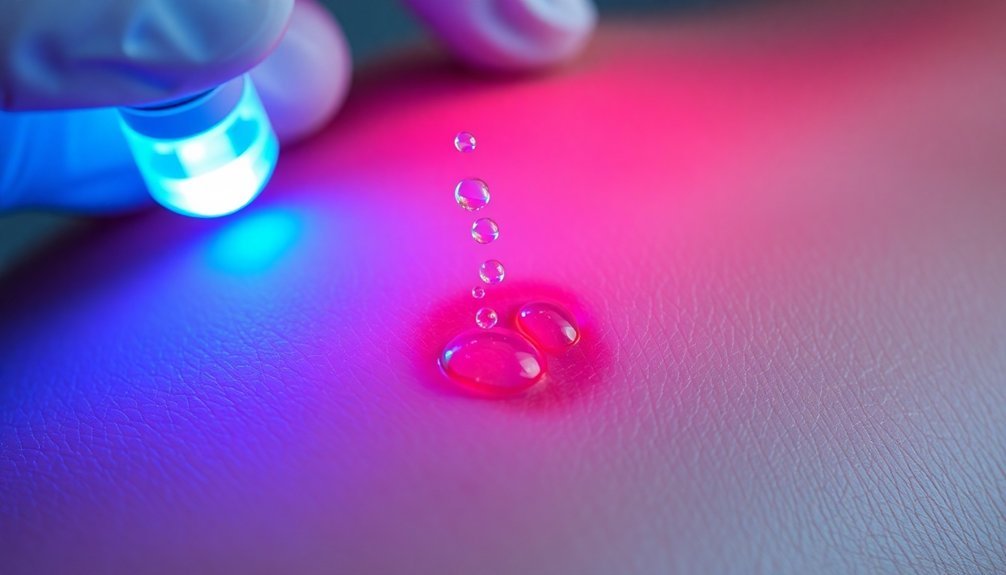
With improved blood flow established through NIR therapy, oxygenation and nutrient delivery become essential components in promoting wound healing. Increased oxygen levels directly enhance cellular metabolism, providing ATP necessary for the energy-demanding processes during wound repair. This boost in oxygen not only aids in cellular activities but also promotes the differentiation of fibroblasts into myofibroblasts, which are fundamental for wound contracture.
The heightened oxygenation supports collagen synthesis, giving the wound matrix the tensile strength it needs. Simultaneously, improved nutrient uptake occurs, as NIR therapy facilitates better delivery of critical nutrients to the wound site. This nutrient influx fuels protein synthesis, important for tissue repair and regeneration. Moreover, the reduction of hypoxia through NIR therapy helps activate various repair mechanisms like angiogenesis, ensuring ideal healing conditions.
Additionally, many diabetic patients experience impaired healing due to the prevalence of prolonged hyperglycemia affecting their wounds. You'll also notice improved expression of key markers associated with clinical outcomes, such as increased Ki-67 expression, indicating enhanced tissue regeneration. As a result, oxygenation and nutrient delivery together form a powerful synergy that drives effective wound healing in diabetic patients, paving the way for faster recovery and improved healing assessments.
Anti-Inflammatory Effects
NIR therapy plays a crucial role in reducing inflammation, a significant barrier to effective wound healing in diabetic patients. By decreasing pro-inflammatory cytokines like TNF-α and IL-1β, this therapy creates a more favorable healing environment.
For instance, irradiation at 660 nm not only lowers these cytokine levels but also down-regulates NFκB, which is a key regulator of inflammation.
Moreover, NIR therapy suppresses inflammatory cell activation, leading to reduced activation and infiltration of leukocytes in the wound area. You'll notice a decrease in CD45+ cells, indicating a lower immune response, along with less expression of inflammatory markers such as caspase-1.
Additionally, it promotes anti-inflammatory pathways by up-regulating genes and growth factors like VEGF and TGF-β. As a result, you get a boost in anti-inflammatory cytokines, enhancing tissue repair and collagen synthesis, which improves wound closure rates.
Clinical evidence backs this up, showing significant reductions in wound size and healing time in NIR-treated diabetic ulcers compared to untreated ones.
Antioxidant Properties
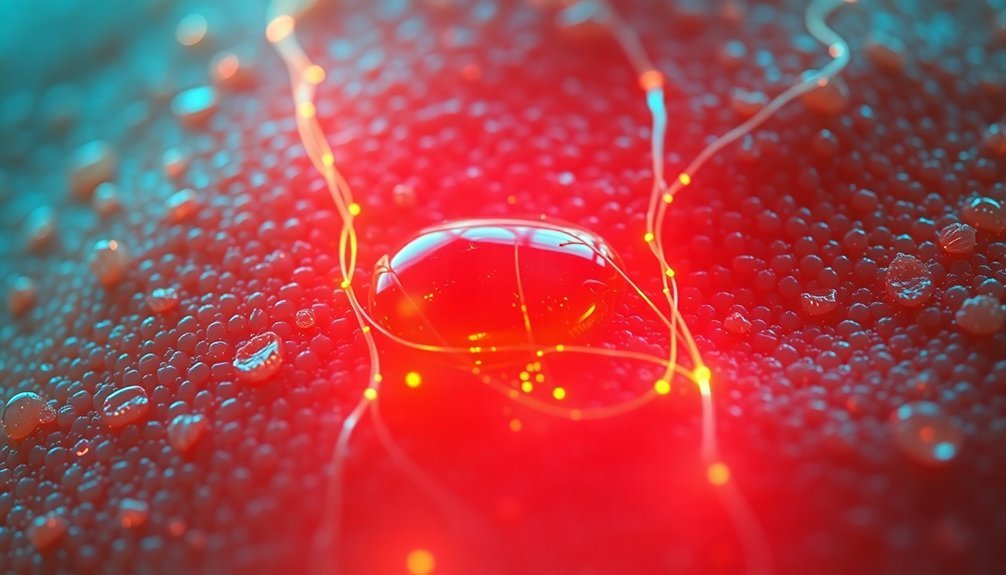
When you use NIR therapy for diabetic wounds, you're tapping into its impressive ability to reduce oxidative stress.
This therapy not only modulates reactive oxygen species production but also creates a more favorable healing environment by promoting cellular metabolism.
You'll see enhanced tissue regeneration as oxidative damage decreases, leading to improved wound healing.
Oxidative Stress Reduction
Oxidative stress plays a significant role in the complications associated with diabetic wounds, and addressing it can greatly enhance healing. NIR therapy is particularly effective in reducing oxidative stress through several mechanisms that promote better wound outcomes.
By enhancing the activity of key antioxidant enzymes, like glutathione reductase and superoxide dismutase, NIR light therapy helps neutralize harmful free radicals that hinder healing.
Here are some notable benefits:
- Increased enzyme activity: NIR light boosts the actions of essential antioxidant enzymes.
- Reduced oxidative markers: Treatment leads to lower levels of 8-OHdG, indicating less oxidative damage.
- Shift to aerobic metabolism: NIR therapy encourages cells to utilize oxygen more effectively, which supports healthier metabolism.
- Suppressed inflammation: The therapy downregulates inflammatory cytokines, reducing excessive stress on healing tissues.
Reactive Oxygen Species Impact
The management of reactive oxygen species (ROS) is key to enhancing healing in diabetic wounds. NIR light therapy effectively modulates intracellular ROS levels, maintaining a balance that avoids excessive oxidative stress. This therapy promotes a moderate increase in ROS, essential for cell signaling and gene transcription, while preventing cellular damage commonly linked to high ROS levels in diabetic conditions.
By shifting cellular metabolism from anaerobic to aerobic, NIR therapy lessens the detrimental effects of ROS. Additionally, it boosts your antioxidant defense system by activating essential enzymes such as glutathione reductase and superoxide dismutase. This upregulation of antioxidant gene products effectively reduces oxidative stress, enhancing cellular viability and proliferation.
NIR light also supports mitochondrial function, increasing ATP production and minimizing mitochondrial damage from ROS. By protecting mitochondria, NIR therapy aids in reducing cellular deterioration and promotes healthier tissue repair.
Through these actions, NIR light therapy alleviates inflammatory responses and apoptosis in wounded fibroblasts, leading to improved collagen synthesis and new blood vessel formation. Consequently, this modulation of ROS accelerates diabetic tissue regeneration, ultimately facilitating quicker wound closure.
Enhanced Healing Environment
NIR therapy creates an enhanced healing environment by greatly reducing oxidative stress, which is essential for accelerating recovery in diabetic wounds. When oxidative stress is minimized, you enable ideal conditions for healing.
NIR therapy helps decrease lipid peroxidation and nitrotyrosine formation, leading to less cellular damage from free radicals. It lowers nitric oxide production and the inflammatory response, further promoting recovery.
Here are some key benefits of NIR therapy's antioxidant properties:
- Decreases pro-inflammatory cytokines like TNF-α and IL-1β.
- Amplifies superoxide dismutase (SOD) gene expression, boosting your body's natural defenses.
- Enhances mitochondrial activity, increasing your cells' energy production.
- Promotes angiogenesis and collagen synthesis, facilitating tissue repair.
Cellular and Molecular Responses
While exploring the effects of photobiomodulation (PBM) on diabetic wounds, researchers have found significant cellular and molecular responses that enhance healing processes.
You'll notice increased cell proliferation and migration in irradiated diabetic fibroblast cells, particularly with 660 nm wavelength irradiation. This wavelength supports cellular viability, even in hypoxic conditions, and stimulates mitochondrial oxygen consumption and ATP production, essential for cellular activities.
You can expect a reduction in oxidative stress and inflammation as PBM lessens pro-inflammatory cytokines like TNF-α and IL-1β, which promotes a less inflammatory environment.
Moreover, angiogenesis becomes more pronounced with PBM, showing increased levels of vascular endothelial growth factor (VEGF), endothelial nitric oxide synthase (eNOS), and epidermal growth factor (EGF).
You'll likely observe enhanced neovascularization and collagen production, contributing to better tissue regeneration in diabetic wounds.
Biochemically, PBM shifts the metabolism from anaerobic to aerobic, crucial for efficient healing. With increased nitric oxide (NO) release, inflammation further diminishes, resulting in reduced oxidative damage.
All these combined cellular and molecular changes create a powerful response, making PBM an effective therapy for diabetic wound healing.
Impact on Healing Time
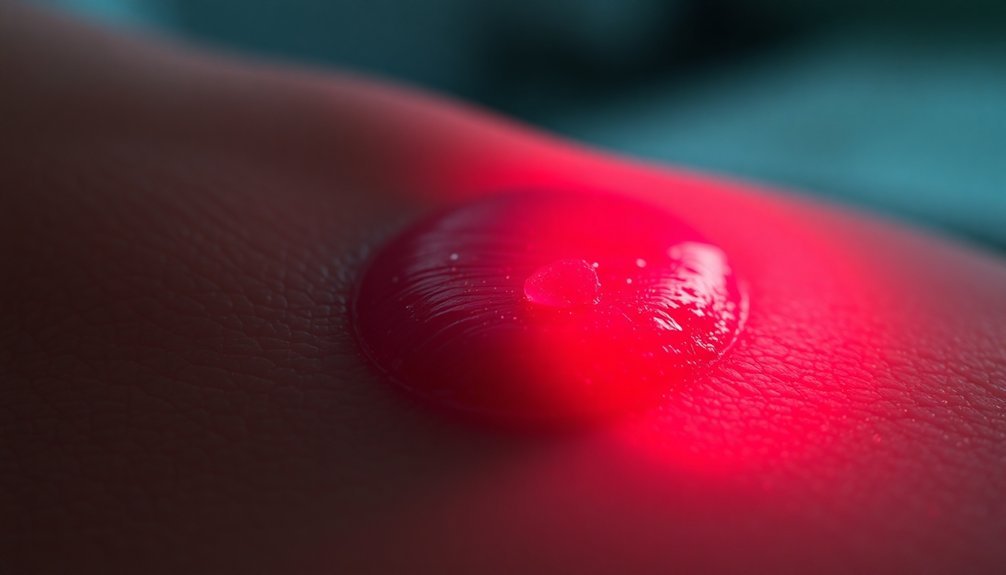
When it comes to healing diabetic wounds, you'll find that NIR therapy considerably speeds up the process.
This therapy enhances wound contraction and improves tissue integrity, leading to faster recovery times.
Faster Wound Contraction
The benefits of NIR therapy are particularly evident in its ability to promote faster wound contraction, greatly impacting overall healing time for diabetic wounds. This method accelerates the healing process through several mechanisms that enhance cellular activity and tissue regeneration.
When you undergo NIR therapy, the treatment can lead to:
- Increased collagen synthesis and organization, essential for wound closure.
- Enhanced angiogenesis, which improves blood flow and nutrient delivery to the wounded area.
- Reduced inflammatory responses, creating a more favorable environment for healing.
- Quicker recruitment of fibroblasts and granulation tissue, critical for skin repair.
Studies have shown that wounds treated with NIR therapy heal considerably faster—21 days versus 40-60 days for untreated wounds.
This rapid contraction not only shortens healing time but also enhances the integrity of the resulting scar, making recovery smoother overall.
Enhanced Tissue Integrity
Enhanced tissue integrity often plays an important role in speeding up healing time for diabetic wounds. With near-infrared (NIR) therapy, you can greatly enhance tissue oxygenation, which is vital for effective wound healing. NIR spectroscopy measures tissue oxygen levels, allowing you to assess wound resolution and make informed clinical decisions.
Here's a breakdown of how NIR therapy improves tissue integrity:
| Aspect | Impact on Healing | Mechanism |
|---|---|---|
| Tissue Oxygenation | Accelerates healing | Increases oxyhemoglobin levels |
| Cellular Processes | Enhances cellular function | Stimulates ATP production |
| Anti-Inflammatory Effects | Reduces inflammation | Lowers oxidative stress |
| Early Identification | Promotes timely interventions | Detects at-risk tissue areas |
Clinical Outcomes
NIR therapy has shown promising clinical outcomes for diabetic wounds, markedly speeding up the healing process. By enhancing blood flow and reducing inflammation, this therapy greatly improves wound healing rates. Clinical trials highlight several key outcomes:
- Enhanced blood flow promotes oxygen and nutrient delivery, aiding cell proliferation and tissue regeneration.
- Reduced inflammation and oxidative stress create a healthier wound environment and minimize tissue damage.
- Faster wound closure is achieved through stimulated cellular functions like migration and collagen production.
- Lower risk of complications, including infections and amputations, leads to better overall quality of life.
Patients treated with NIR therapy experience markedly faster complete healing times compared to diabetic controls. The therapy not only reduces wound size but also accelerates healing rates, which are essential for diabetic individuals prone to chronic wounds.
The evidence supports that NIR therapy effectively promotes healing, making it an important element in managing diabetic wounds. By integrating this therapy into treatment plans, you could see notable improvements in healing outcomes and overall patient well-being.
Optimal Treatment Parameters
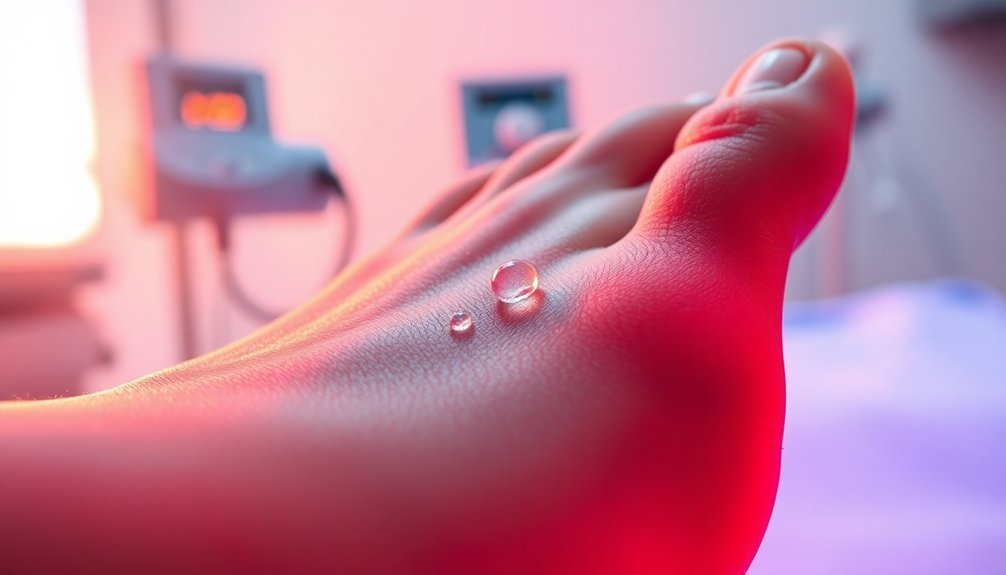
When considering ideal treatment parameters for NIR therapy, you'll want to focus on dosage and frequency, as well as the specific wavelength and power density.
Research highlights that certain wavelengths, like 633 nm and 808 nm, deliver significant healing benefits for diabetic wounds.
Additionally, finding the right fluence and treatment schedule can enhance the overall effectiveness of your therapy.
Dosage and Frequency
In the domain of diabetic wound therapy, determining the right dosage and frequency is essential for achieving ideal healing outcomes. Clinical studies show that longer treatment duration considerably impacts healing efficacy. For instance, 40-minute sessions (FIR-40) yield better results than 20-minute ones (FIR-20). Treating three times per week over four weeks allows your body to benefit from progressive healing improvements.
Here are the optimal parameters you should consider:
- Duration: Aim for 40-minute treatment sessions for enhanced efficacy.
- Frequency: Schedule treatments three times weekly to maximize healing potential.
- Consistency: Maintain regular treatment to observe continuous improvement.
- Blood Flow: Expect increased blood perfusion post-treatment, essential for optimal wound healing.
The consistent application of these dosages and frequencies reveals enhanced neo-vessel formation and reduced inflammation, both critical for recovery.
Adopting the right treatment approach can make a considerable difference in your healing journey, paving the way for better clinical outcomes.
Ultimately, the goal of FIR therapy for diabetic wounds is to foster tissue regeneration while minimizing oxidative stress, thereby facilitating a faster and more effective healing process.
Wavelength and Power Density
Effective photobiomodulation (PBM) for diabetic wound healing hinges on selecting the right wavelength and power density.
You'll want to focus on red and near-infrared wavelengths, particularly those between 600 to 1070 nm. Specifically, 633 nm has shown remarkable effectiveness in aiding diabetic wounds and burns. Other beneficial wavelengths include 660 nm and 808 nm, as these promote cellular migration, viability, and proliferation.
In terms of power density, ideal levels range from 0.1 to 0.3 W/cm², with lower densities often yielding better outcomes. For instance, using 4 mW/cm² at 632.8 nm five times a week has been effective in hastening wound healing in diabetic models.
A power density of 11 mW/cm² at 660 nm showed reductions in apoptosis and inflammatory responses in wounded fibroblasts, while higher densities like 40 mW (904 nm) enhanced collagen production and angiogenesis.
Striking the right balance here is essential; too high a power density can have negative effects.
As a result, understanding and using the ideal wavelength and power density is key to maximizing the benefits of NIR therapy in diabetic wound management.
Future of NIR Therapy
Looking ahead, the future of NIR therapy in treating diabetic wounds holds immense promise. As the field evolves, enhancements in treatment protocols and technology are set to transform patient care markedly. You can expect several advancements:
- Standardized Dosimetry: Ensuring consistency in treatment doses could lead to better outcomes across diverse patient populations.
- Combination Therapies: Merging NIR with nanotechnology, like metal nanoparticles, could amplify healing effects.
- Personalized Treatments: Tailoring NIR therapy to individual patient needs will enhance effectiveness and satisfaction.
- Home-Based Devices: Convenient, user-friendly devices for at-home use could expand access and compliance.
Continued research is essential to deepen our understanding of NIR therapy's mechanisms, paving the way for innovative applications.
As clinical trials yield promising results, the focus will shift toward optimizing treatment frequencies, durations, and parameters. The goal is to not only reduce wound healing times but also elevate the overall quality of life for patients.
This forward momentum in NIR therapy looks to create a new paradigm in wound care, establishing effective, accessible, and patient-centered solutions.
Frequently Asked Questions
Is NIR Therapy Safe for All Diabetic Patients?
NIR therapy isn't safe for everyone. It's essential you consult your healthcare provider before starting treatment, especially if you have other chronic conditions or take medications that might interact with the therapy. Always prioritize safety.
How Long Do the Effects of NIR Therapy Last?
The effects of NIR therapy can last beyond treatment, as studies show continued healing, improved tissue strength, and reduced inflammation. You'll see these benefits persist, even after sessions have ended, ensuring long-term wound care.
Can NIR Therapy Be Combined With Other Treatments?
Yes, you can combine NIR therapy with other treatments like surgical interventions, topical therapies, and anti-inflammatory medications. This combination enhances healing by boosting granulation tissue growth and reducing inflammation, leading to improved outcomes for wounds.
Are There Any Side Effects of NIR Therapy?
Yes, there're minimal side effects associated with NIR therapy. You might experience slight skin sensitivity, but serious reactions are rare. Always wear protective eyewear to avoid eye exposure, ensuring a safe treatment experience.
How Is NIR Therapy Administered in Clinical Settings?
In clinical settings, you can receive NIR therapy through laser or LED devices. Sessions typically last 20 minutes, happening three to six times a week, focusing on your specific wound care needs and progress.
In Summary
In summary, NIR therapy offers a promising solution for diabetic wounds by enhancing blood flow, boosting oxygen and nutrient delivery, and reducing inflammation. Its antioxidant properties further support healing, leading to improved clinical outcomes and shorter healing times. As research evolves, understanding ideal treatment parameters will maximize its effectiveness. With the potential for ongoing advancements, NIR therapy could become an essential component in wound care, offering hope for those struggling with diabetes-related complications.

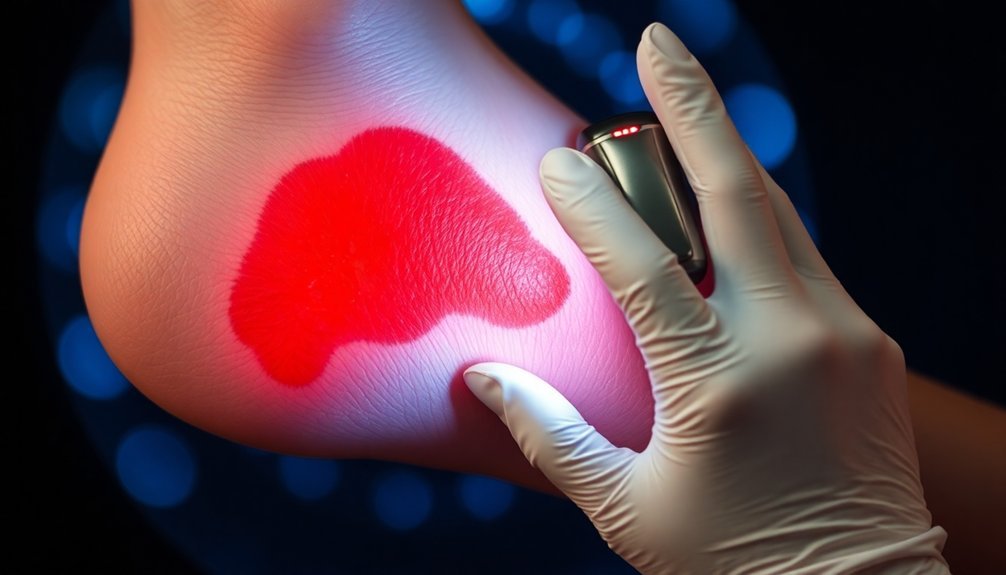



Leave a Reply